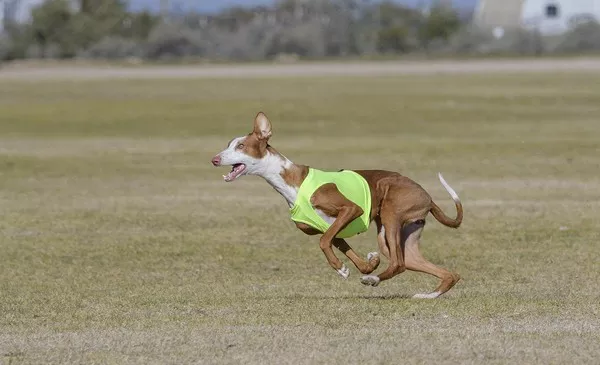Foxhounds, specifically bred to track and chase foxes during hunting expeditions, are renowned for their stamina, intelligence, and strong prey drive. These dogs were historically developed for one purpose—hunting—and this history deeply influences their behavior, habits, and needs today. For pet owners considering adopting a Foxhound or those already with one, understanding whether Foxhounds can be destructive is crucial. In this article, we will explore the Foxhound breed’s characteristics, their temperament, and how these factors may contribute to behaviors that could be perceived as destructive. By the end of this article, you will have a comprehensive understanding of whether Foxhounds can be destructive and how to manage or prevent this behavior.
The History and Purpose of Foxhounds
To understand the temperament of the Foxhound, it’s helpful to first look at its history. The Foxhound is part of the hound group of dogs, and its primary purpose was to help hunt foxes during fox hunts, particularly in countries like the United Kingdom and the United States. These dogs were bred to have incredible endurance, a sharp sense of smell, and a strong prey drive. Foxhounds were required to track and chase foxes over long distances, often working as part of a pack. The emphasis on stamina and focus, combined with their natural instincts, makes them highly energetic and intelligent.
Given their original role, Foxhounds are accustomed to being outdoors for long periods and need a significant amount of exercise and stimulation. When they don’t receive enough physical or mental activity, they may resort to undesirable behaviors to expend their pent-up energy.
Foxhound Temperament: Friendly Yet Independent
Foxhounds are known for their friendly, social nature. They are typically good with people, children, and other dogs. Their pack mentality makes them inclined to bond with their family, often seeking interaction with everyone in the household. However, they also possess an independent streak, which can sometimes lead to challenges in training. Foxhounds are not as eager to please as some other breeds, which means they may require more patience and consistency when it comes to obedience training.
Their independence and intelligence mean they can often make decisions on their own, which could be problematic in situations where they are left to their own devices without supervision. Without a clear understanding of boundaries, Foxhounds may engage in behaviors that could be interpreted as destructive.
Can Foxhounds Be Destructive?
To assess whether Foxhounds are destructive, it’s essential to understand the behaviors that might be considered destructive and the reasons behind them. Destructive behavior in dogs generally refers to actions like chewing furniture, digging, excessive barking, or escaping the yard. For a breed like the Foxhound, these behaviors may stem from a few key factors:
Boredom and Lack of Exercise: As we’ve already mentioned, Foxhounds were bred for long hours of physical activity. They have high energy levels and require daily exercise to remain happy and healthy. Without adequate exercise, they may engage in destructive behaviors to release their pent-up energy. This can include chewing on furniture, digging up the garden, or knocking over items in the home.
Separation Anxiety: Foxhounds are pack animals and often form strong bonds with their human family members. When left alone for extended periods, they may experience separation anxiety, leading to behaviors such as excessive barking, whining, or even destructive chewing. This is particularly true if the dog is not used to being alone or has not been adequately trained to manage their time apart from their family.
Prey Drive: Foxhounds have a strong prey drive, meaning they are hardwired to chase and hunt small animals. This instinct can sometimes lead them to engage in destructive behaviors such as digging or escaping fences in search of prey. A Foxhound’s desire to pursue moving objects or animals may drive them to escape your yard or pull on the leash when out for walks.
Lack of Training and Socialization: Like any dog, Foxhounds need proper training and socialization from a young age. If they are not taught appropriate behaviors early on, they may develop habits that could be considered destructive. Foxhounds tend to be independent thinkers, and without clear guidance from their owners, they may decide for themselves when and where to exhibit certain behaviors.
Boredom or Frustration with Restriction: Foxhounds are naturally curious and may get frustrated when confined to a space or not allowed to explore. If they’re kept indoors for too long or don’t have access to a safe, enclosed outdoor area, they may engage in destructive behaviors as a way to express their frustration.
How to Prevent Destructive Behavior in Foxhounds
While it’s true that Foxhounds have the potential to engage in destructive behavior, most of these issues can be prevented or mitigated with proper care, training, and management. Here are several tips for preventing destructive behavior in Foxhounds:
1. Provide Plenty of Exercise
Foxhounds require a significant amount of physical activity to remain content. Aim for at least one hour of vigorous exercise each day, but this can vary depending on the dog’s age, health, and individual energy levels. Daily walks, runs, or hikes are excellent ways to tire out your Foxhound. You can also engage in more interactive activities like fetch or agility training to provide both mental and physical stimulation. Keep in mind that the more exercise your Foxhound gets, the less likely they are to develop destructive habits out of boredom.
2. Mental Stimulation
In addition to physical exercise, Foxhounds need mental stimulation to stay engaged and prevent destructive behavior. This breed is intelligent and will benefit from puzzle toys, treat-dispensing toys, or interactive games that challenge their problem-solving skills. Obedience training sessions can also provide mental stimulation and help strengthen your bond with your dog. Regularly introducing new tasks or activities can keep your Foxhound’s mind sharp and focused.
3. Crate Training
Crate training can be a valuable tool for managing your Foxhound’s behavior when you’re not at home. A crate offers your dog a safe and comfortable space to relax when left alone. Foxhounds, with their strong pack instincts, may feel more secure in a crate, reducing anxiety and preventing destructive behaviors like chewing or digging. However, it’s essential to ensure that crate training is done gradually and positively, so your dog doesn’t develop negative associations with the crate.
4. Set Boundaries and Consistent Training
Foxhounds are independent thinkers, so consistent and positive training is necessary to keep them well-behaved. Establish clear boundaries early on, and use positive reinforcement techniques to reward desired behaviors. Training should focus on basic commands, leash walking, and socialization with other dogs and people. While they may not be as eager to please as some breeds, Foxhounds can still respond well to training when approached with patience and persistence.
5. Prevent Escape Attempts
Given their strong prey drive, Foxhounds may try to escape your yard if they detect something interesting. Make sure your fence is high and secure, as these dogs are skilled at climbing or digging. Consider installing a fence with a reinforced bottom to prevent digging. When out on walks, always keep your Foxhound on a leash and avoid areas where they might be distracted by wildlife or other animals. Investing in a long lead or a secure fenced-in play area can allow your Foxhound to roam safely without the risk of escape.
6. Manage Separation Anxiety
If your Foxhound suffers from separation anxiety, it’s crucial to address this issue as early as possible. Start by gradually getting your dog used to being alone for short periods, slowly increasing the time away as they become more comfortable. You can also provide mental stimulation while you’re away, such as leaving a puzzle toy or a safe chew toy to keep your dog occupied. In severe cases, you may want to consult a professional dog trainer or behaviorist to help manage your Foxhound’s anxiety.
7. Socialization
Socializing your Foxhound with other dogs, animals, and people is essential for developing a well-rounded, well-behaved dog. Early socialization can help your Foxhound feel comfortable in various situations and reduce anxiety-related behaviors. Take your Foxhound to dog parks, obedience classes, or on walks where they can interact with others in a controlled environment.
Conclusion
Foxhounds are intelligent, energetic, and independent dogs that can be prone to destructive behaviors if their physical and mental needs aren’t met. However, with proper exercise, training, and management, these behaviors can be prevented or minimized. Foxhounds require owners who are willing to invest time and effort into their care and development. When given the right environment, these dogs can be loving, loyal companions without being destructive.
If you’re considering adopting a Foxhound or already own one, it’s important to remember that while they may have an innate tendency to engage in behaviors like chewing, digging, or escaping, these habits can largely be avoided with the right approach. With plenty of exercise, mental stimulation, and consistent training, your Foxhound will thrive in your home and become the well-behaved companion you desire.
So, are Foxhounds destructive? Not necessarily. But, like any dog breed, their behavior is heavily influenced by their environment, care, and training. With the right approach, a Foxhound can be a happy, non-destructive part of your family for many years to come.
Related Topics:






















